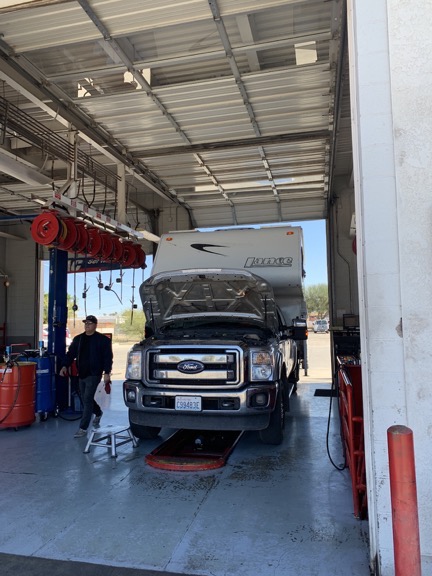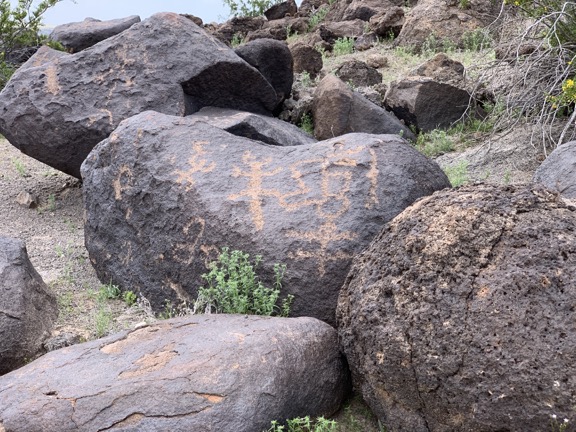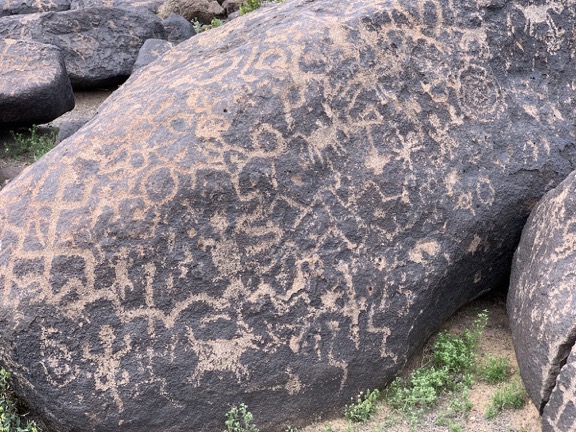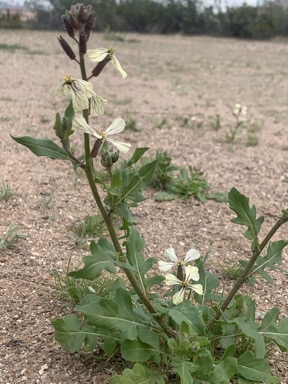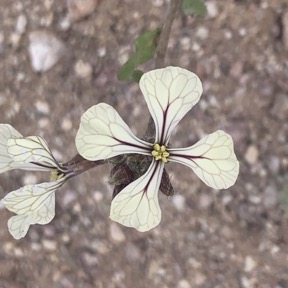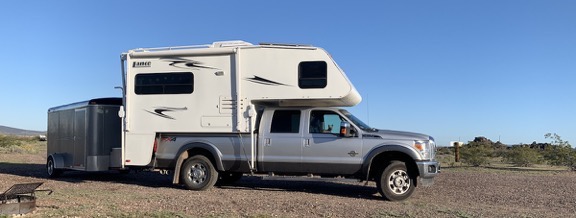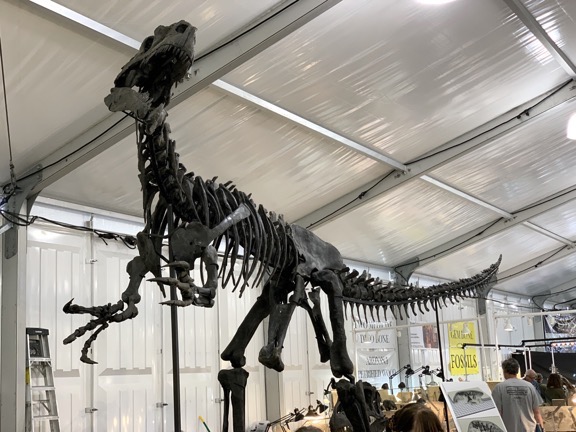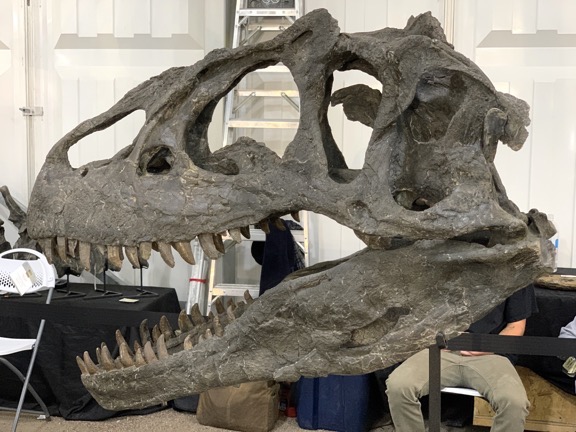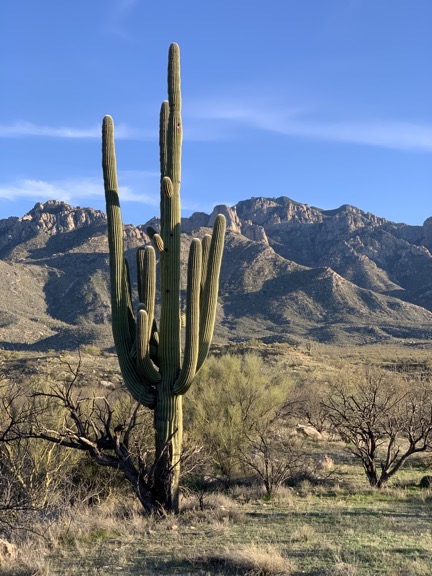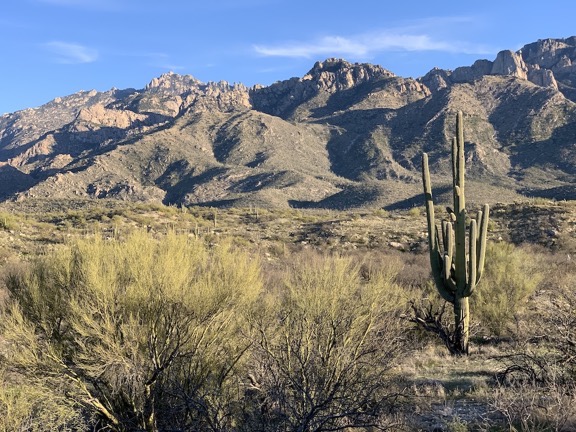I spend the first night of my vacation close to home — sort of.
• Red Top Lookout
• American River Campsite
• Mt Rainier and the Buck Creek Campsite
• A Driving Day with a Crappy Campsite
• The Blacksmithing Weekend
• Dungeness Recreation Area
After being stuck at home for three full months on cherry drying standby duty, and then wasting two weeks more at home catching up on the things I should have been doing while I was stuck there, I finally loaded up my truck camper (T2) and hit the road on my late summer vacation.
First, a Look Back
The late summer/early autumn vacation has been a sort of tradition with me for the last bunch of years:
- Last year (2019), I did an abbreviated T2 camper trip out to the Olympic Peninsula by way of Mt Rainier, scheduling it to coincide with a rock show where I was selling rocks and jewelry. I also took a second cruise on the David B, this time in the San Juan Islands on a photo excursion. And I even went back to Tacoma in T2 in October to take two jewelry classes.
- The year before (2018) was a two-week trip back east, which included about a week in Washington DC followed by a road trip in my brother’s Maserati to visit very good, very old friends in Vermont and Upstate New York.
- In 2017, I drove T2 south to Oregon for the total eclipse of the sun and then goofed around for a few more days in eastern Washington. Then, in October, I took a two-week road trip south, to visit friends and various national parks in Utah, Colorado, and Arizona before repositioning my truck, T2, and my little boat in Arizona for the winter.
- In 2016, I did a road trip along the North Cascades Highway and into Canada, returning through Omak. That was my first truck camper trip in my first truck camper (The Turtleback), which I sold to downsize a bit. (I sort of miss it; it was very deluxe.)
- In 2015, I was still putting the finishing touches on my home, so I did a short, weekend long trip to the North Cascades Environmental Learning Center for a seminar about mushroom hunting.
- Of course, in 2014 and 2013, development of my property (purchased in 2013) and construction of my home kept me very busy, although I did find time in 2013 to drive back to Arizona and pick up my household goods and Honda S2000, which had been waiting for me in my old hangar in Wickenburg. (Yeah, I know I blogged in June of that year that long distance movers took all that stuff then, but I lied in my blog so my wasband wouldn’t know my possessions were still in my Wickenburg hangar.) I also went back east to say goodby to my godfather, Jackie, who passed away before I arrived.
In winding back through time, I’m surprised at how much ground I covered every year. And, of course, none of this includes my winter travels or occasional springtime trips. I may not travel far and wide, but I travel often.
Traveling with a Turtleback
Truck campers may be small, but they’re the perfect size for one person and one or two small dogs. (I would not want to be stuck in a truck camper with a whiney adult — or child, for that matter.)
In this 3,200 pound box that sits inside my very large pickup truck’s full-sized bed, I have a queen sized bed, television (with built-in DVD player), three burner stove, oven, microwave, two-basin sink with 30 gallons of fresh water storage, refrigerator, freezer, dinette, and plenty of storage for clothes, food, and household items. The bathroom may be tiny and it may double as a shower stall, but it has standard camper toilet and little sink with 30 gallons each of black (toilet) and gray (sink/shower) water. There’s air conditioning, heat, and a water heater. Most everything runs on propane or battery power; there are two 5-gallon propane tanks and 200 watts of solar power on the roof to keep the batteries charged. When I’m not plugged into A/C power, the only things I can’t use are the air conditioning and the microwave. In the winter, I travel with a generator in case I can’t get enough solar power into my batteries and need to top them off. It’s all the comforts of home in a relatively small package.
But the real beauty of camping in a truck camper is that I can take it almost anywhere I can take my truck. And since my truck is a Ford F350 SuperDuty Diesel with 4WD, I can drive it almost anywhere. I can also park it almost anywhere — downtown in tourist town, at a hiking trailhead, or in one of the notoriously small Trader Joe’s parking lots.
This is great for the kind of road trip traveling I do. If I’m driving along and see a sign for a waterfall or scenic view or historic windmill or — well, you get the idea — I want to be able to follow the sign without having to worry about whether I can park my rig — or even turn around — once I get there. You don’t realize how important this is until you’ve dragged a 36-foot fifth wheel trailer between Arizona, Washington, and California a few times and have to pass up stops along the way simply because you know you won’t be able to fit.
The added benefit of my rig’s setup is its off-the-grid capabilities. That’s super important to me because I don’t like camping in campgrounds.
Red Top
On the first night of my trip, I put my rig to the test (again) with a drive up to the Red Top trailhead.
Red Top is a peak along the Teanaway Ridge near Cle Elem. It’s famous among local rock hounds for the agate beds nearby. To others, it’s interesting for the historic fire tower atop the rocky peak. There are numerous hiking trails in the area and its high elevation (5500 feet or so) means it’s cooler in the summer.
I got it in my head that I wanted to camp up near the trailhead. I’d been up there once before, hiking with a friend. Before that, I’d tried to bring T2 up there but wasn’t sure of the way and wound up turning around and camping just off the road for the night. I figured I’d get there before sunset, settle in with my pups, and hike up to the fire tower in the morning.
I got a late start: 4 PM. No worries. It wasn’t that far. As the crow flies, I bet it’s less than 25 miles from my house. But we weren’t flying so we had to take the long way around: through Wenatchee, west on Route 2, south on 97 at the big Y, over Blewett Pass, and then up the long, winding dirt/gravel road to the trailhead parking lot.
I can’t remember if I asked Google Maps or Apple Maps to direct me to the turn off Route 97, which is easy to miss. It guided me up the road, but told me I had arrived when I definitely had not arrived. The map showed the road ending but the road clearly went on ahead of me. I kept going. And going.
The road got rough around 5 miles in. Nothing the truck couldn’t handle, of course, but I did have to slow down a lot more than I normally would have because I didn’t want to shake up my camper too badly. Finally, we made it to the top. (I tracked the miles on the way back out the next day: 7.5, all uphill.) The parking area was empty. I was pleased to see a toilet building I didn’t remember being there. I found a large, level spot a bit farther on, backed in, and killed the engine.
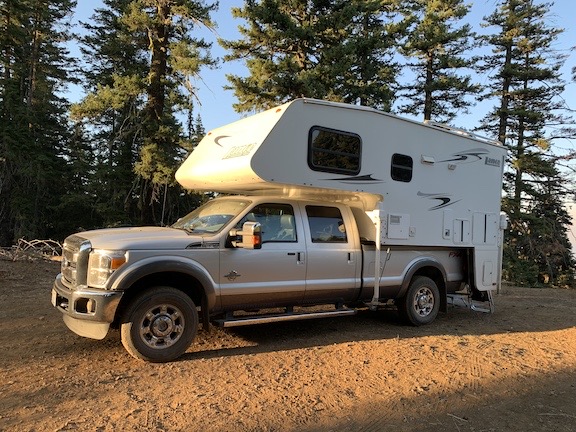
T2 parked at our Red Top campsite.
I walked over to the toilet building with my dogs to check out the signs there and see if the building was unlocked. It was. And it was clean. With toilet paper. Whoa.
The signs were the usual signs you find at places like that. History of the fire tower that was still up the trail. Reminders to keep the place clean and not to start fires. A sign letting you know that a missing person who was likely a murder victim might be in the area. (Okay, so that’s not a usual sign.)
The one sign I didn’t see was the one that said “No Camping” which had spoiled so many potential campsites in the past. No sign? I thought it fair to assume that camping was allowed. (And I really do need to write a blog post on my thoughts on real camping vs the kind of camping I do when I’m in transit.)
This is the point at which a person in a campground might be dealing with finding a good spot, getting the camper set up, cursing the idiot two spots down for turning on his generator, or keeping dogs leashed up so as not to break campground rules. I didn’t have to deal with any of this. I could park anywhere that looked like a parking spot, there was no one to bother me, and there were no rules (other than common sense rules that really didn’t need to be posted anywhere). And it was dead quiet; the only sound was the wind in the trees. Even the birds had already settled down for the night.
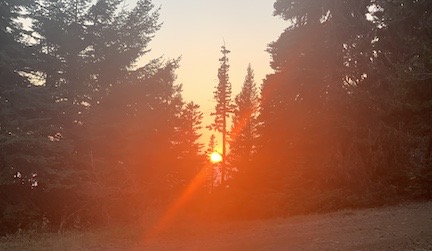
A smoky sunset through the trees.
I saw the sun set between the trees not long after we arrived. I fed my pups, made dinner and fed myself, and then went out with my pups so we could all do our business without me having to add to the camper’s blackwater tank. Then, as it was getting dark, we climbed back into T2 and settled down for the evening. I spent some time reading and doing crossword puzzles before falling asleep.
I woke up in the middle of the night. Nothing woke me — I just woke. I seldom sleep straight through on any night. I spent some more time reading, then turned to my favorite sleep aid: a Bob Ross video on YouTube. Apparently, 1-2 bars of LTE was enough to get Internet access.
The Hike
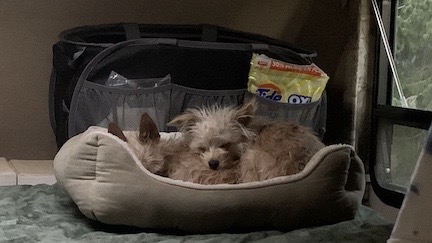
Lily and Rosie asleep together in their bed. It was chilly enough that morning to turn on the heat.
It was light when I woke up, but it was that weird light you get when the sun shines though smoke. There were fires all over Washington — none of which were near me — and the whole state had varying amounts of smoke in the air. There was definitely more smoke that morning than there had been the night before, but as the day progressed, the smoke seemed to settle, leaving the sky at our altitude much clearer.
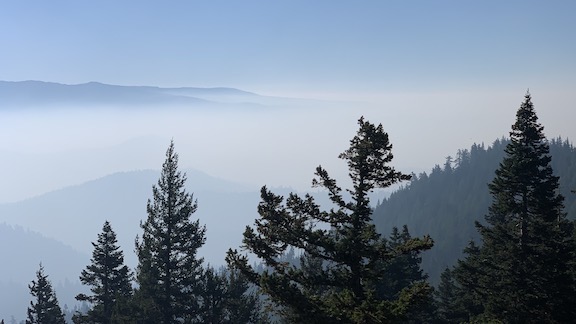
Here’s the view that morning looking east. The valleys were completely socked in with smoke.
My girls and I took another pee trip, then went back inside for breakfast. I had some veggies from my garden sautéed with two tiny eggs from my young chickens, who have just begun to lay. I played around with GaiaGPS, the hiking app I’ve been using for years, and managed to calculate the length of the hike I planned. While I did all this, a truck came into the parking area, drove past us, and parked a bit farther on. That got Rosie barking. I don’t know where the driver went — or even if he left the truck — but he was gone 30 minutes later, leaving the place to us again.
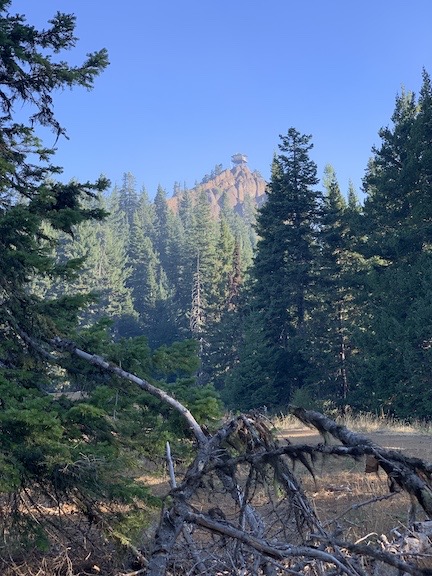
Red Top Lookout Tower, from near the trailhead. The hike looks a lot harder than it is.
We hiked up to the fire tower, making plenty of stops along the way. I’ve never been good at hiking uphill and age hasn’t made me any better. There were also things to see along the way, including great views of Mt Rainier rising out of the smoky valley and the fire tower perched almost impossibly on the rocks. The trail itself was a pleasant mix of exposed rocky terrain and rather dense forest. We did the half mile in about 30 minutes.
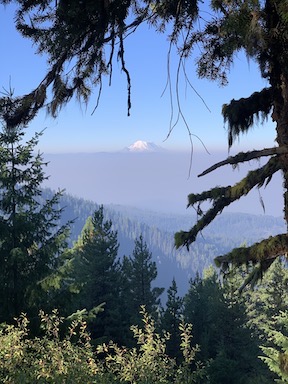
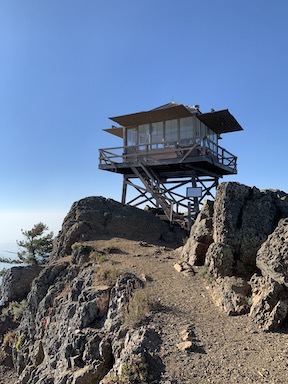
Left: A view of Mt. Rainier through the trees shot from along the trail. Right: A closeup view of Red Top Lookout Tower.
The window shutters were up on all four sides of the tower, but the trapdoor at the top of the stairs was padlocked. A sign said the tower was open to visitors from 9 AM to 6 PM daily. It was 8:45, but I seriously doubted anyone would show up within the next 15 minutes to open it for me. The wind was wicked up there and although it wasn’t cold, it wasn’t pleasant, either.
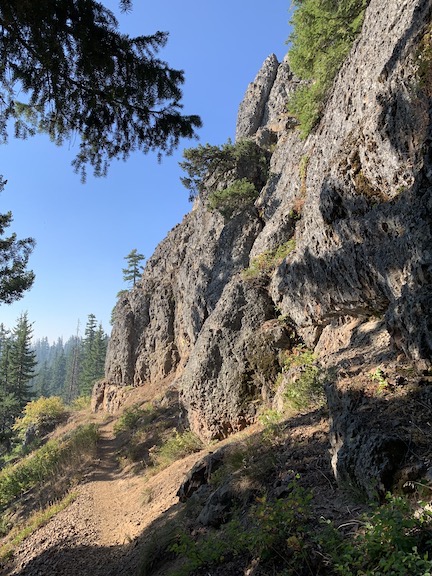
The return trail was pretty level after the initial drop via switchbacks. For part of the distance, it clung to the side of a steep hill.
We hung around for a little while, then continued on the trail past the tower. It soon entered a series of switchbacks that took us down the other side of the peak and into forest. Eventually, it leveled out at a crossroads. A left turn would take us to the agate beds about a half mile away. A right turn would take us along the side of the peak, back to the trailhead. We turned right.
My pups — who were not on a leash — were very well behaved on the hike. They stayed very close to me as we walked — sometimes ahead of me and sometimes right behind me on the narrow trail. They seemed to be having fun. They’re nearly a year old now — I think their birthday is October 1 — and are acting more like dogs than puppies most of the time. It’s a real pleasure to hike with them.
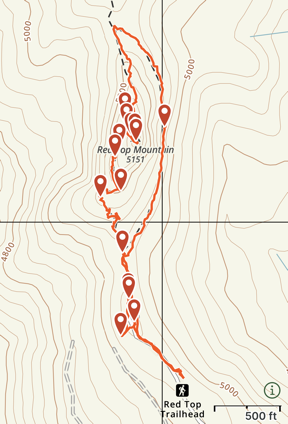
Here’s the track from our hike. The markers are places where I took photos. You can see them all on the GaiaGPS website.
Back in the trailhead parking lot, a minivan was parked near the toilet building. A woman sat in it. I asked if she’d come to open the tower and she said no. Her companion emerged from the toilet building and we all chatted for a while while my dogs played with theirs. They were tent camping in the campground not far from the turn to come up the mountain. They commented on having to listen to the road. (I can’t even imagine.🙄) They’d come up to look for geodes. I had my doubts about whether they’d find any, but I did fill them in on the fire tower and trails and where the agate beds could be found. We went back inside T2, where I fiddled around with my iPad for a while. It took them 45 minutes to leave their car and start the hike.
Onward
We left a while later.
Another great thing about a truck camper is that there’s not much to break down for moving before you go. In the past, I’ve had a hybrid trailer with hard sides and tent-like beds — what a pain in the butt to set up and later stow! (What was I thinking?) Even my big fifth wheel was a chore to prepare for moving with furniture to stow and slides to close up. In the truck camper, it’s a matter of making sure the table and countertops are free of loose objects and all cabinets, windows, and vents are closed. Put up the back step and away I go.
I should mention here that it isn’t always that quick and easy. When I park for a month along the Colorado River in December, I take the camper off the truck so I can drive the truck without moving the camper. It’s easy enough to do; the four legs are motorized and controlled with a hand-held remote. Unfasten the four straps holding the camper onto the truck, lower the legs to raise the camper, carefully drive away, and then lower the camper back down to the ground to reduce stress on its legs. In that case, leaving isn’t quite as quick because I have to reverse the procedure to get the camper back on the truck. It takes roughly as long to do that as it takes my friend Janet to hook up her trailer and its anti-sway bars — maybe a bit longer if the straps need adjusting.
As I drove the 7-1/2 miles back down to pavement, I tried to imagine what the drive would have been like with a trailer in tow. I’d been thinking a lot about replacing T2 with a 17- to 21-foot pull trailer similar to Janet’s. It would be a bit more comfortable during my winter travels. But would I have taken it up to Red Top? Although I felt confident that I could have made the trip with a small trailer behind my truck, that’s only because I already knew what to expect. Not knowing road conditions in advance changed everything. I knew from experience on my back road travels that roads could be washed out, terrifyingly narrow along cliff faces, or simply too rough for lower profile vehicles. Suitable places to turn around with a trailer in tow were rare. Not having driven up to Red Top for a few years, I didn’t know what I’d be facing the day before. Heck, I didn’t even know for sure that I could camp there. I suspect I never would have tried if I had a trailer instead of T2.
And that brings me back to the reason I bought a truck camper in the first place: easy camping comfort with complete flexibility. (See “Traveling with a Turtleback” above.)
The drive to pavement took 50 minutes — for just 7-1/2 miles! — a fact that surprised me when I checked the timer. Was it worth it? As I pulled onto busy route 97, a main thoroughfare through Blewett Pass for cars and trucks, and glimpsed parked campers in the Mineral Springs Campground right off the road, I knew that it was.
And I started wondering whether that couple and their dog would be moving their campsite up to the space I had vacated later that afternoon.

